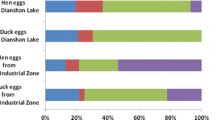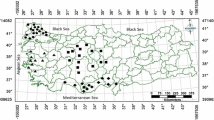Abstract
Eighty ducks (Sheldrake, Anas platyrhynchos) from Zhejiang Province, China were fed capsules containing commercialized hexabromocyclododecanes (HBCDs) at low (0.8 mg/kg/day) or high (1.6 mg/kg/day) exposure level, or only maize starch for 21 days. Then the next 21 days was set as depuration period. Ducks were euthanizated at 0, 7, 14 and 21 days after last dose and ten duck tissues including skin, tongue, intestines, heart, gizzard, muscle, liver, lung, brain and blood were sampled, separately. Three HBCDs including α-HBCD, β-HBCD and γ-HBCD in duck tissue samples were analyzed. At the end of depuration period, the total HBCDs concentration in skin was significantly higher than those in the other tissues (p < 0.05). The elimination rates of the three isomers in skin, tongue, intestines, heart, gizzard and brain were in the order β- > γ- > α-HBCD. The enantioselectivity of three HBCDs enantiomers was also studied in ten duck tissues. It was shown that the EF (enrichment factor) for two γ-HBCD enantiomers was significant lower than 0.5 (p < 0.05) in gizzard, heart, muscle, tongue, intestinal and liver at the end of depuration day, showing a selective accumulation of (+)-γ-HBCD in these tissues. This study provided a reference for evaluation on the accumulation of the persistent contamination of HBCDs in edible poultry.


Similar content being viewed by others
References
Abdallah MA, Harrad S (2011) Tetrabromobisphenol-A,hexabromocyclododecane and its degradation products in UK human milk: relationship to external exposure. Environ Int 37:443–448
BSEF. Bromine science and environmental forum. (2009) http://www.bsef.com. Accessed 14–15, 2009
Covaci A, Gerecke AC, Law RJ et al (2006) Hexabromocyclododecanes (HBCDs) in the environment and humans: a review. Environ Sci Technol 40:3679–3688
Du M, Lin L, Yan C et al (2012) Diastereoisomer- and enantiomer-specific accumulation, depuration, and bioisomerization of hexabromocyclododecanes in zebrafish (Danio rerio). Environ Sci Technol 46:11040
Esslinger S, Becker R, Maul R et al (2011) Hexabromocyclododecane enantiomers: microsomal degradation and patterns of hydroxylated metabolites. Environ Sci Technol 45:3938–3944
Fournier A, Feidt C, Marchand P et al (2012) Kinetic study of γ-hexabromocyclododecane orally given to laying hens (Gallus domesticus). “Transfer of HBCD in laying hens”. Environ Sci Pollut Res 19:440–447
Law K, Palace VP, Halldorson T et al (2006) Dietary accumulation of hexabromocyclododecanediastereoisomers in juvenile rainbow trout (Oncorhynchus mykiss) I: Bioaccumulation parameters and evidence of bioisomerization. Environ Toxicol Chem 25:1757–1761
Letcher RJ, Mattioli LC, Marteinson SC et al (2015) Uptake, distribution, depletion and in ovo transfer of isomers of hexabromocyclododecane flame retardant in diet-exposed American kestrels (Falco sparverius). Environ Toxicol Chem 34:1103–1112
Li H, Shang H, Wang P et al (2013) Occurrence and distribution of hexabromocyclododecane in sediments from seven major river drainage basins in China. J Environ Sci 25:69–76
Li B, Yao T, Sun H et al (2015) Diastereomer- and enantiomer-specific accumulation, depuration, bioisomerization, and metabolism of hexabromocyclododecanes (HBCDs) in two ecologically different species of earthworms. Sci Total Environ 542:427–434
Marvin CH, Tomy GT, Armitage JM et al (2011) Hexabromocyclododecane: current understanding of chemistry, environmental fate and toxicology and implications for global management. Environ Sci Technol 45:8613–8623
Morf LS, Tremp J, Gloor R et al (2005) Brominated flame retardants in waste electrical and electronic equipment: substance flows in a recycling plant. Environ Sci Technol 39:8691
Palace VP, Pleskach K, Halldorson T et al (2008) Biotransformation enzymes and thyroid axis disruption in juvenile rainbow trout (Oncorhynchus mykiss) exposed to hexabromocyclododecane diastereoisomers. Environ Sci Technol 42:1967
Peck AM, Pugh RS, Moors A et al (2008) Hexabromocyclododecane in white-sided dolphins: temporal trend and stereoisomer distribution in tissues. Environ Sci Technol 42:2650
Rajaei F, Bahramifar N, Sari AE et al (2010) Erratum to: PCBs and organochlorine pesticides in ducks of Fereydoon-kenar wildlife refuge in Iran. Bull Environ Contam Toxicol 84:577–581
Szabo DT, Diliberto JJ, Hakk H et al (2010) Toxicokinetics of the flame retardant hexabromocyclododecane alpha: effect of dose, timing, route, repeated exposure, and metabolism. Toxicol Sci 117:282–293
Tomy GT, Wes B, Thor H et al (2004) Biomagnification of α- and γ-hexabromocyclododecane isomers in a Lake Ontario food web. Environ Sci Technol 38:2298–2303
Tomy GT, Palace V, Marvin C et al (2011) Biotransformation of HBCD in biological systems can confound temporal-trend studies. Environ Sci Technol 45:364–365
Tue NM, Takahashi S, Suzuki G et al (2013) Contamination of indoor dust and air by polychlorinated biphenyls and brominated flame retardants and relevance of non-dietary exposure in Vietnamese informal e-waste recycling sites. Environ Int 51:160–167
Yao F, Wang JM, Chen J et al (2017) Efficient detection of α-, β-, and γ-hexabromocyclododecane isomers and their hydroxylated metabolites in poultry tissues based on dispersive solid phase extraction using an enhanced lipid-removing material combined with UPLC-MS/MS. Food Anal Method 11:1–9
Zegers N, Mets A, Van BR et al (2005) Levels of hexabromocyclododecane in harbor porpoises and common dolphins from western European seas, with evidence for stereoisomer-specific biotransformation by cytochrome p450. Environ Sci Technol 39:2095–2100
Acknowledgements
This work was supported by support from the Zhejiang Provincial Natural Science Foundation of China (LY070002, LY14B070008), National Waterfowl Industry Technology System of China (CARS-42-27), the Project of Science and Technology Plan of Zhejiang Province (2014C32044), Nature Science Foundation of China (No. 21507114), State Key Laboratory Breeding Base for Zhejiang Sustainable Pest and Disease Control (2010DS700124-KF1701, 2010DS700124-ZZ1602, 2010DS700124-ZM1604).
Author information
Authors and Affiliations
Corresponding authors
Rights and permissions
About this article
Cite this article
Xia, W., Wang, J., Yang, H. et al. Bioaccumulation and Distribution of Hexabromocyclododecane Isomers in Duck Tissues. Bull Environ Contam Toxicol 100, 754–759 (2018). https://doi.org/10.1007/s00128-018-2342-4
Received:
Accepted:
Published:
Issue Date:
DOI: https://doi.org/10.1007/s00128-018-2342-4




